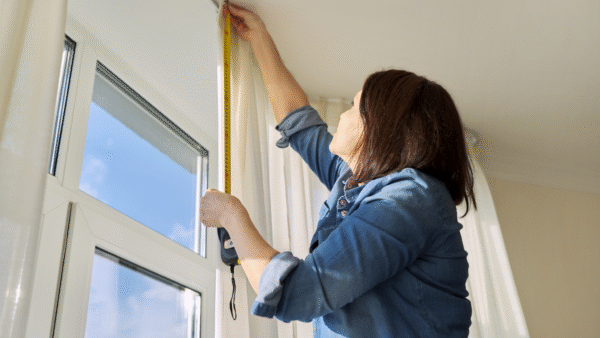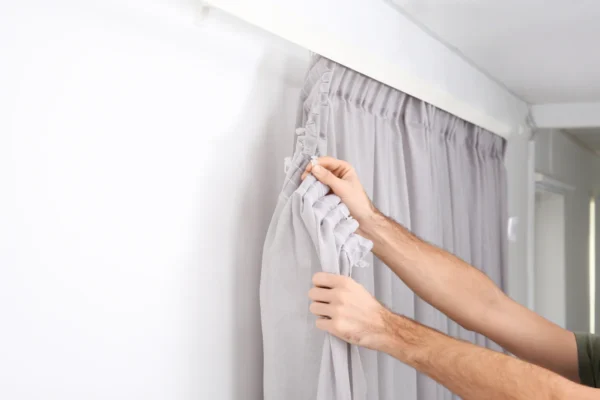Have you ever looked at your bare windows and dreamed of the ideal curtains to makeover your room? One essential step you cannot ignore before exploring the realm of fabrics and designs is determining the width of your curtain. This guide will help you through the process so that each time you get the right fit for your windows.
Why Accurate Measurements Matter
What if you’ve found the perfect living room curtains, only to discover they’re too short or narrow when you hang them up. Frustrating, right? That’s why exact measurements are crucial. Whether your goal is light control, seclusion, or just a modern appearance, correctly fitting curtains not only look better but also operate better.
Getting Started: What You’ll Need
Before we start, gather these simple tools:
- Metal measuring tape
- Pencil and paper
- Step ladder (for high windows)
Now that you’re equipped, let’s get measuring!
Step-by-Step Guide to Measuring Curtain Width
1. Decide on Your Curtain Rod Placement
First things first: where will your curtain rod go? For a classic look, place the rod about 4-6 inches above the window frame and extend it 3-6 inches on each side. This arrangement makes the window seem bigger and lets your drapes cover it when closed.
If you’re feeling daring, you might even consider how to cover an entire wall with curtains for a dramatic effect. Here you will measure the whole wall width rather than only the window.
2. Measure the Width of Your Window or Desired Coverage Area
Measuring the width of your window frame or the space you wish your curtains to cover using your metal measuring tape Measure from the window frame or your selected coverage area’s outside edges.
3. Add Extra Width for Fullness
The magic takes place right here. You will need additional breadth to get that collected appearance when your curtains are closed. Depending on how full you wish your curtains to seem, multiply your estimated width by 1.5 to 3.
For example:
- For light fullness: Multiply by 1.5
- For medium fullness: Multiply by 2
- For heavy fullness: Multiply by 2.5 to 3
Assume your window is 60 inches wide and you desire medium fullness. You would multiply 60 by 2 to get a 120-inch curtain width overall.
4. Consider Your Curtain Style
Different curtain styles may require different measurements:
- For single-panel curtains, use your calculated width from Step 3.
- For double-panel curtains, divide your total width by 2 to get the width for each panel.
- For sheer curtains Dubai or any other location, you might want extra fullness for a flowy look.
5. Don’t Forget About Lining
If you are choosing blackout curtains or another type of lined curtains, keep in mind that the lining should be rather thinner than the main fabric. This stops the lining from showing behind closed curtains.
Once you have your precisely measured curtains, take good care to keep them looking fantastic. Regular maintenance—like learning how to clean dusty curtains—will prolong their life and keep your windows looking new.
Special Considerations
Bay Windows: Measure each section separately and treat them as individual windows.
Corner Windows: Measure each window separately, but allow for extra fabric where the curtains will meet at the corner.
Electric curtains: If you’re installing electric curtains Dubai, follow the manufacturer’s specific measuring instructions, as these systems often have unique requirements.
Office Curtains: In a professional setting, you might prefer a sleeker look with less fullness. Multiply your measured width by 1.5 for a polished appearance.
Curtain Hardware Matters
The type of curtain hardware you choose can affect your measurements:
- Rod Pocket Curtains: Measure the rod’s circumference to ensure the pocket is wide enough.
- Grommet or Eyelet Curtains: Account for the space between grommets when calculating fullness.
- Tab Top Curtains: Consider the length of the tabs in your overall curtain length.
Quick Fixes for Common Curtain Mishaps
If you find your measurements are slightly off after curtain installation Dubai, don’t panic! Here are some quick fixes:
- Too wide: Use tie-backs to gather excess fabric elegantly. Alternatively, consider adding pleats for a tailored look.
- Too narrow: Add decorative side panels for extra width. You can also install a wider rod to extend the curtains further.
- Uneven lengths: Adjust the rod height or use hem tape for a quick fix. For a permanent solution, consider having them professionally hemmed.
- Gapping in the middle: Install a center support bracket to prevent rod sagging and ensure curtains meet in the middle.
- Light leakage around edges: Add velcro strips to the edges of your curtains and window frame for a tighter seal.
- Curtains don’t stack back fully: Install holdbacks or tiebacks to keep curtains neatly pushed aside when open.
- Rod is visibly bending: Upgrade to a sturdier rod or add center supports to distribute the weight evenly.
- Curtains don’t close completely: Consider adding an extra panel or switching to a traverse rod for smoother operation.
- Wrinkles and creases: Use a steamer or iron on appropriate settings to smooth out the fabric. For persistent wrinkles, try hanging the curtains in a steamy bathroom.
- Static cling: Lightly mist curtains with a mixture of water and fabric softener to reduce static, especially in dry climates.
Conclusion
Getting the right measurements for curtains may seem like a small thing, but it’s the key to making any room look organized and polished. Following these guidelines and considering the special qualities of your windows and desired design will help you to get at curtain excellence.
Remember, that investing time to measure precisely now will help you avoid problems (and possibly multiple shopping trips) downstream. Curtains Dubai Online is also available for free consultation and measurement. Hire us for your perfect measure of your windows today.







